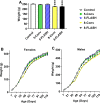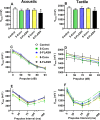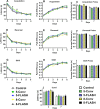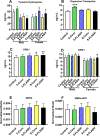Cognitive and behavioral effects of whole brain conventional or high dose rate (FLASH) proton irradiation in a neonatal Sprague Dawley rat model
- PMID: 36112695
- PMCID: PMC9481014
- DOI: 10.1371/journal.pone.0274007
Cognitive and behavioral effects of whole brain conventional or high dose rate (FLASH) proton irradiation in a neonatal Sprague Dawley rat model
Abstract
Recent studies suggest that ultra-high dose rates of proton radiation (>40 Gy/s; FLASH) confer less toxicity to exposed healthy tissue and reduce cognitive decline compared with conventional radiation dose rates (~1 Gy/s), but further preclinical data are required to demonstrate this sparing effect. In this study, postnatal day 11 (P11) rats were treated with whole brain irradiation with protons at a total dose of 0, 5, or 8 Gy, comparing a conventional dose rate of 1 Gy/s vs. a FLASH dose rate of 100 Gy/s. Beginning on P64, rats were tested for locomotor activity, acoustic and tactile startle responses (ASR, TSR) with or without prepulses, novel object recognition (NOR; 4-object version), striatal dependent egocentric learning ([configuration A] Cincinnati water maze (CWM-A)), prefrontal dependent working memory (radial water maze (RWM)), hippocampal dependent spatial learning (Morris water maze (MWM)), amygdala dependent conditioned freezing, and the mirror image CWM [configuration B (CWM-B)]. All groups had deficits in the CWM-A procedure. Weight reductions, decreased center ambulation in the open-field, increased latency on day-1 of RWM, and deficits in CWM-B were observed in all irradiated groups, except the 5 Gy FLASH group. ASR and TSR were reduced in the 8 Gy FLASH group and day-2 latencies in the RWM were increased in the FLASH groups compared with controls. There were no effects on prepulse trials of ASR or TSR, NOR, MWM, or conditioned freezing. The results suggest striatal and prefrontal cortex are sensitive regions at P11 to proton irradiation, with reduced toxicity from FLASH at 5 Gy.
Conflict of interest statement
These experiments were funded by Varian, a Siemens Healthineers company that granted the authors intellectual freedom to publish the data. This does not alter our adherence to PLOS ONE policies on sharing data and materials.
Figures










Similar articles
-
Latrophilin-3 heterozygous versus homozygous mutations in Sprague Dawley rats: Effects on egocentric and allocentric memory and locomotor activity.Genes Brain Behav. 2022 Sep;21(7):e12817. doi: 10.1111/gbb.12817. Epub 2022 Aug 19. Genes Brain Behav. 2022. PMID: 35985692 Free PMC article.
-
Whole brain proton irradiation in adult Sprague Dawley rats produces dose dependent and non-dependent cognitive, behavioral, and dopaminergic effects.Sci Rep. 2020 Dec 9;10(1):21584. doi: 10.1038/s41598-020-78128-1. Sci Rep. 2020. PMID: 33299021 Free PMC article.
-
Effects of (+)-methamphetamine on path integration and spatial learning, but not locomotor activity or acoustic startle, align with the stress hyporesponsive period in rats.Int J Dev Neurosci. 2009 May;27(3):289-98. doi: 10.1016/j.ijdevneu.2008.12.003. Epub 2008 Dec 24. Int J Dev Neurosci. 2009. PMID: 19136054 Free PMC article.
-
Review of Conventional and High Dose Rate Brain Radiation (FLASH): Neurobehavioural, Neurocognitive and Assessment Issues in Rodent Models.Clin Oncol (R Coll Radiol). 2021 Nov;33(11):e482-e491. doi: 10.1016/j.clon.2021.09.002. Epub 2021 Sep 20. Clin Oncol (R Coll Radiol). 2021. PMID: 34548203 Free PMC article. Review.
-
Value of water mazes for assessing spatial and egocentric learning and memory in rodent basic research and regulatory studies.Neurotoxicol Teratol. 2014 Sep-Oct;45:75-90. doi: 10.1016/j.ntt.2014.07.003. Epub 2014 Aug 10. Neurotoxicol Teratol. 2014. PMID: 25116937 Review.
Cited by
-
Preclinical Ultra-High Dose Rate (FLASH) Proton Radiation Therapy System for Small Animal Studies.Adv Radiat Oncol. 2023 Dec 17;9(3):101425. doi: 10.1016/j.adro.2023.101425. eCollection 2024 Mar. Adv Radiat Oncol. 2023. PMID: 38379895 Free PMC article.
-
Development of a Single-Neurosphere Culture to Assess Radiation Toxicity and Pre-Clinical Cancer Combination Therapy Safety.Cancers (Basel). 2023 Oct 10;15(20):4916. doi: 10.3390/cancers15204916. Cancers (Basel). 2023. PMID: 37894283 Free PMC article.
-
Irradiation and Alterations in Hippocampal DNA Methylation.Epigenomes. 2024 Jul 5;8(3):27. doi: 10.3390/epigenomes8030027. Epigenomes. 2024. PMID: 39051185 Free PMC article. Review.
-
Tests for learning and memory in rodent regulatory studies.Curr Res Toxicol. 2024 Jan 18;6:100151. doi: 10.1016/j.crtox.2024.100151. eCollection 2024. Curr Res Toxicol. 2024. PMID: 38304257 Free PMC article.
-
Examining the Occurrence of the FLASH Effect in Animal Models: A Systematic Review and Meta-Analysis of Ultra-High Dose Rate Proton or Carbon Ion Irradiation.Technol Cancer Res Treat. 2024 Jan-Dec;23:15330338241289990. doi: 10.1177/15330338241289990. Technol Cancer Res Treat. 2024. PMID: 39512217 Free PMC article.
References
-
- Greenberger BA, Pulsifer MB, Ebb DH, MacDonald SM, Jones RM, Butler WE, et al.. Clinical outcomes and late endocrine, neurocognitive, and visual profiles of proton radiation for pediatric low-grade gliomas. International journal of radiation oncology, biology, physics. 2014;89(5):1060–8. doi: 10.1016/j.ijrobp.2014.04.053 - DOI - PubMed
-
- Ma TM, Grimm J, McIntyre R, Anderson-Keightly H, Kleinberg LR, Hales RK, et al.. A prospective evaluation of hippocampal radiation dose volume effects and memory deficits following cranial irradiation. Radiotherapy and oncology: journal of the European Society for Therapeutic Radiology and Oncology. 2017;125(2):234–40. doi: 10.1016/j.radonc.2017.09.035 - DOI - PMC - PubMed
-
- Ventura LM, Grieco JA, Evans CL, Kuhlthau KA, MacDonald SM, Tarbell NJ, et al.. Executive functioning, academic skills, and quality of life in pediatric patients with brain tumors post-proton radiation therapy. Journal of neuro-oncology. 2018;137(1):119–26. doi: 10.1007/s11060-017-2703-6 - DOI - PubMed
Publication types
MeSH terms
Substances
Grants and funding
LinkOut - more resources
Full Text Sources

